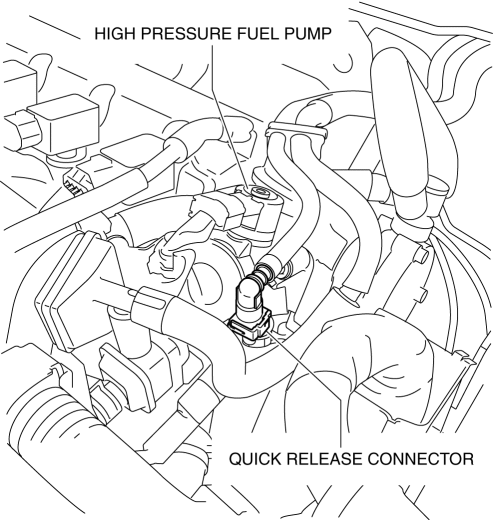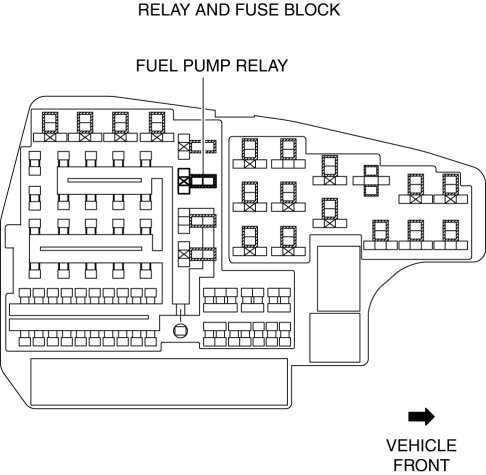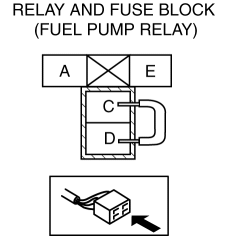Mazda CX-5 Service & Repair Manual: Fuel Draining Procedure
WARNING:
-
Fuel line spills and leakage from the pressurized fuel system are dangerous. Fuel can ignite and cause serious injury or death and damage. To prevent this, complete the following inspection with the engine stopped.
-
Fuel is very flammable liquid. If fuel spills or leaks from the pressurized fuel system, it will cause serious injury or death and facility breakage. Fuel can also irritate skin and eyes. To prevent this, always complete the “Fuel Line Safety Procedure”, while referring to the “BEFORE SERVICE PRECAUTION”.
-
A person charged with static electricity could cause a fire or explosion, resulting in death or serious injury. Before performing work on the fuel system, discharge static electricity by touching the vehicle body.
CAUTION:
-
Disconnecting/connecting the quick release connector without cleaning it may possibly cause damage to the fuel pipe and quick release connector. Always clean the quick release connector joint area before disconnecting/connecting using cloth or soft brush, and make sure that it is free of foreign material.
1. Complete the “BEFORE SERVICE PRECAUTION”..
2. Disconnect the negative battery cable..
3. Disconnect the quick release connector as shown in the figure..

4. Connect a long hose to the disconnected quick release connector and drain the fuel into a container used for collecting gasoline.
5. Drain the fuel from the fuel tank using the following procedure:
-
Using M-MDS
-
Connect the negative battery cable..
-
Connect the M-MDS to the DLC-2.
-
Using the simulation function “FP”, start the fuel pump..
-
Without using M-MDS
-
Remove the fuel pump relay.

CAUTION:
-
Short the specified terminals because shorting the wrong terminal of the relay and fuse block may cause malfunctions.
-
-
Using a jumper wire, short fuel pump relay terminals C and D in the relay and fuse block.

-
Connect the negative battery cable and operate the fuel pump..
CAUTION:
-
The fuel pump could be damaged if it is operated while there is no fuel in the fuel tank. Verify the amount of fuel being discharged from the hose and stop operation of the fuel pump when essentially no fuel is being discharged.
-
6. Stop the fuel pump using the following procedure.
-
Using M-MDS
-
Using the simulation function “FP”, stop the fuel pump..
-
Disconnect the negative battery cable..
-
Without using M-MDS
-
Remove the jumper wire to stop the fuel pump..
-
Disconnect the negative battery cable..
 Fuel Distributor
Fuel Distributor
Purpose, Function
Distributes fuel pumped from the high pressure fuel pump to each fuel injector.
Construction
The fuel distributor is installed to the cylinder head.
...
 Fuel Filler Cap Inspection
Fuel Filler Cap Inspection
Leakage Inspection
1. Perform the following tester (evaporative emission system tester (134-01049A))
self-test:
NOTE:
If the tester does not work correctly during self-test, refer to the ...
Other materials:
Power Window Subswitch Removal/Installation
1. Disconnect the negative battery cable..
2. Remove the cover A.
3. Insert a tape-wrapped fastener remover shown in the figure and remove the
tab B in the direction of arrow (1).
4. Slide the power window subswitch cover in the direction of the arrow (2) shown
in the figure and re ...
Front Side Frame (Partial Cutting) Removal [Panel Replacement]
Symbol Mark
Removal Procedure
1. Drill the 4 locations indicated by (A) shown in the figure, then remove suspension
mounting reinforcement and outer frame reinforcement.
2. Rough cut location indicated by (B) shown in the figure.
3. Drill the 6 locations indicated by (C) shown in the fig ...
Low Fuel Warning Light
Purpose
The low fuel warning light warns the driver that the remaining fuel level
is low.
Function
The instrument cluster calculates the fuel quantity based on the following
CAN signals, and if a remaining fuel amount of approx. 10 L {2.6 US gal, 2.2
Imp gal} (fuel gauge ...
